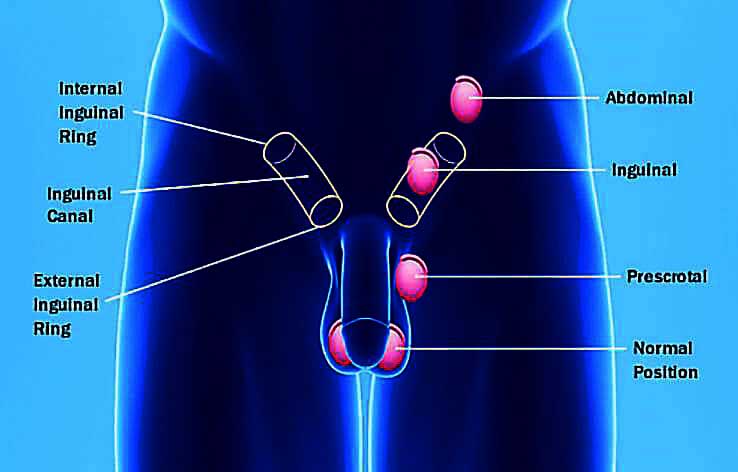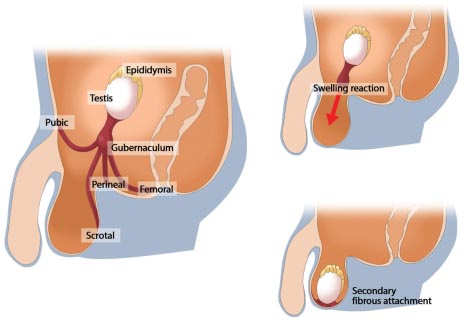Table of Contents
Orchiopexy Overview
Orchiopexy (or orchidopexy) is a surgical procedure that permanently relocates an undescended (cryptorchid) testicle into the scrotum. Orchiopexy is often used to characterize the surgery used to correct testicular torsion.
Who Need Orchiopexy?
Undescended testicle and testicular torsion are the two conditions that necessitate orchiopexy. Undescended testicles are typically corrected in puberty to avoid potential problems such as infertility and an increased risk of testicular cancer.
A baby boy’s testicles grow within his abdomen while he is still in his mother’s womb. They descend into the scrotum shortly before birth. This movement does not occur in approximately 4% of infant boys. Movement occurs before the age of one for half of these infants. If the testicles have not moved into the scrotum by the age of one, the pediatrician and parents must decide whether to use surgery, known as an orchiopexy (OR-kee-o-PEK-see), to move the testicles into the scrotum.

Undescended testicles do not cause discomfort, but they may cause groin swelling or a lump (the place where the lower abdomen meets the inner thigh). If not surgically corrected, undescended testicles can lead to infertility and other medical issues later in life, such as the growth of tumors or hernias. If the problem is not addressed, the region becomes more vulnerable to injury.
Under general anesthesia, the undescended testicle is moved through the scrotum. General anesthesia puts your child to sleep and is needed for the operation so that his reflexes are totally relaxed. Since your child may not feel or remember the procedure, general anesthesia makes it simpler and safer to perform.
Caudal anesthesia is used in conjunction with general anesthesia to block pain in the low back, tummy, and lower trunk area, providing up to 4 hours of pain relief after surgery. Caudal anesthesia is usually more effective in younger children. If a caudal injection is ineffective or unnecessary, the surgeon can administer a local anesthetic injection to your child.
Home Preparation
When general anesthesia is required, there are strict eating and drinking guidelines that must be followed in the hours leading up to the procedure. You can receive a phone call from a nurse between the hours of 1 and 9 p.m. on the business day before your child’s surgery. (These calls are not made by nurses on weekends or holidays.) Please have paper and a pen on hand to jot down these vital instructions.
Based on your child’s age, the nurse will give you detailed eating and drinking instructions. The following are the standard eating and drinking guidelines. Regardless of your child’s age, you must obey the precise instructions provided to you over the phone by the nurse.
Preparation may vary according to the age of the child. Such as;
Child Below 1 Year
Formula-fed babies can be given formula up to 6 hours before their scheduled delivery time.
Breastfed babies can nurse up to 4 hours before their scheduled arrival time.
Child Above 1 Year
Do not offer any solid food or non-clear liquids after midnight the night before the surgery. This includes milk, formula, pulp juices, coffee, and chewing gum or sweets.
The procedure of Orchiopexy in Short
Before the Operation
Patients preparing for orchiopexy should not consume any food or drink after midnight the night before surgery. If a medicine is prescribed for the day of, the patient can take it with a small sip of water.
During the Operation
Patients undergoing orchiopexy are given general anesthesia so that they do not experience discomfort or remain conscious throughout the procedure. The surgeon will make a small incision in the groin (near the testicle) and identify the damaged testicle. The testicle is tested before being inserted into the scrotum.
After the Operation
Following orchiopexy, the patient is led to a recovery room and closely monitored for complications. The average hospital stay is very short, and most patients are discharged the same day, although this varies depending on the patient. It is important for patients to rest for a few weeks after surgery to ensure proper healing. Especially in young boys who enjoy sports or games that could injure the newly repaired testicle.
Possible Complications
- Excessive bleeding
- Problems from general anesthesia, such as wheezing or sore throat
- Infection in the area
- Blood clots(rare)
- Injury to the closest anatomical structures
- Damage to the testicle
- The testicle moves back into the groin
Lapartoscopic Orchiopexy
Nowadays, laparoscopic Orchiopexy is becoming more popular. Let’s know some general facts about that.
Anesthesia
General anesthesia is usually used
Procedure
Small incisions may be made in one or both groins. Long, thin instruments would be inserted into the incisions. The instruments will be used to pull the testicle into a pouch created in the scrotum. Stitches would be used to keep it in place. Stitches will also be used to seal the incision.
Laparoscopic orchiopexy takes about 1 hour to complete.
The patient does not need to stay in the hospital for long. Usually, he can go home on the same day.
Recovery Time
Usually, it takes 2 weeks to recover. It may vary from child to child.
Some Notes about Orchiopexy
- This surgery is performed to transfer a young boy’s testicles from his abdominal area to the scrotum, a skin sac that keeps the testicles outside the body.
- Your child’s surgery will be performed under general anesthesia, which ensures he will be unconscious during the procedure.
- When general anesthesia is required, there are special eating and drinking guidelines that must be followed in the hours preceding surgery.
- To alleviate pain after the surgery, your child will be given a numbing medication—either a caudal injection in the low back or directly into the incision, or cut—during the procedure.
- This procedure takes approximately 45 minutes, but recovery from anesthesia can take several hours.
Parents Role in Home After the Operation
When your child is released and returns home, he will still be groggy and should rest for the day.
When your child returns home, limit his diet to clear liquids such as water, Gatorade, Popsicles, or Kool-aid for a couple of hours to ensure his stomach settles after the surgery and the car ride home. If your child tolerates these liquids well, he can begin a light diet of soft foods such as applesauce, soup, toast, bananas, rice, or hot cereal after a couple of hours. He should avoid greasy foods that last in the stomach for an extended period of time, such as pizza and fast food. The next day, your child will resume a regular diet.
Medication for Pain Control
Your child may take Tylenol® or Motrin® 4 hours after the operation to relieve pain as the anesthesia wears off. After two days, pain relief is rarely needed. If your child is over the age of 5, the physician will write you a prescription for Tylenol® or codeine elixir in the event that he or she requires extra pain medicine. You should not fill this prescription until you know how your child is doing.
You will be instructed on how to properly care for your child’s dressing. Your surgeon can advise you to apply an antibiotic ointment, such as Neosporin®, to the suture area 2 to 3 times a day.
Note: Never try any medication without consulting a doctor.
Bathing of the Child
For around 5 days, the incision should not be soaked.
If your child is wearing diapers, he will need “washcloth” baths for 4 to 5 days.
If your child is toilet trained, he will need washcloth baths for 4 to 5 days before taking a fast shower. If the cotton dressing becomes wet, it can be removed and replaced with a band-aid.
Playing or Regular Activity
- When your child will continue regular activities will be determined by the surgeon.
- If your child feels good, he might be able to return to school as soon as the next day, and probably within 2 or 3 days of the surgery.
- No biking for a week.
- Active involvement in contact sports and fitness class is prohibited before the surgeon’s follow-up appointment (usually 4 to 6 weeks).
- Swimming may be allowed one week after the operation.

Summery
An orchiopexy is a surgical intervention that either repairs or prevents a testicle from retracting. The testicle is moved from the abdomen or groin region and into the scrotum, according to how it is located (skin sac below the penis). The doctor would then use a “tacking stitch” to surgically bind the testicle to the scrotum.
Last Updated on February 23, 2022 by Learn From Doctor Team





